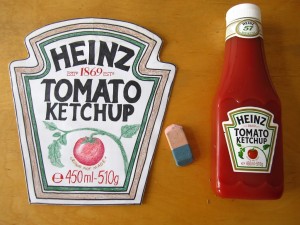 |
| Thank god you can at least get Heinz ketchup here. What would be the point of living without Heinz ketchup? |
Living in Germany has upsides and downsides; culture shocks and culture clashes; pleasant surprises and painful realisations. But these all pale into insignificance when you finally have to come to terms with the most disturbing fact of all: it’s quite difficult to find baked beans in Berlin.
The best substitute for Golden Syrup in Germany is Zuckerrübensirup, sugar beet syrup. This is an interesting substance. It’s a dark, dark, treacly stuff, either pure or as ‘ÜberRübe’, a sugar-beet and glucose-fructose-syrup hybrid, which makes up for its impurity with its hilarious name. It does the job texture-wise and baking-wise, but has an interesting flavour on its own: a rich and caramelly taste which finishes with the kind of nutty, tannic dryness you get from raw beetroot. Most importantly, it is the stickiest substance known to mankind. While making this fridge cake, I was able to glue the lid to my elbow, my spatula to the lid, a piece of garbage to the floor…you cannot contain it. It coats the entire kitchen in a viscous layer of adhesive tar, and after you have cooked with it, every step you tread across the kitchen floor makes that squeaky ‘unpeeling sticker’ noise. It’s delicious stuff though, and I can imagine a spoonful would make a tremendous addition to a tomato stew or a pot of Greek yogurt.
As for the chocolate digestives, you have an array of different biscuits of the ‘generic brown’ variety to choose from. Most supermarkets do their own brand of ‘Hafercookies’, oat cookies, which are very nice but can sometimes break your teeth. Another option is Hobbits, a Hobnob-copy with a lurid orange packet that looks like it was designed on Microsoft Paint. You might like to use Butterkeks, which are more like Rich Teas in flavour and appearance, but unlike Rich Teas Butterkeks do not make you wonder what you are doing with your life to be subjecting yourself to such a lamentable excuse for a biscuit. I opted for the Hafercookies in a tribute gesture to the beloved digestives of my homeland, but decided to shake it up by adding in some Spekulatius biscuits, spiced little windmill-shaped things from the Netherlands which appear in Christmas and are sold in enormous packages as heavy as a house brick.
Self-raising flour is a tricky one. Normally you would add baking powder to plain flour, but the internet is full of roughly fifteen million different suggestions for what the proportions ought to be. I use 1 tsp to 100g of flour, as a rule of thumb. However, German baking powder seems to be particularly flimsy – perhaps that’s why German cake tends to be a yeasted, hefty thing you could use to prop a door open – so I tend to add one more teaspoon ‘for the pot’, so to speak.
Other ingredients are interesting because while widely available, they’re also just different enough to behave in a funny way. Whipping cream, for example, has about 7-10% less fat in it than good old British heart-attack whipping cream, so although it does whip up nicely it takes fifteen sweaty minutes of frantic whisking to get there. For this reason the Germans have invited ‘Sahnesteif’, a kind of whipping catalyst, but I refuse to use it on principle; if I wanted weird additives in my cake I wouldn’t bother baking it myself in the first place, and what better way is there to show your love than a big mound of cream whipped with dediated elbow grease alone. Kidney beans are another weird one – and I certainly don’t advocate mixing them with whipped cream wherever the heck you are. Kidney beans in Germany have sugar added to the canning liquid; not enough to make them a delicious pudding, but just enough that they taste disarmingly sickly. Perhaps this is a plus point if you want to puree them and make them into a Vietnamese bean cake, but otherwise it’s a strange and unwelcome addition to something that has its place in wholesome, chunky winter stews et al. Since living in Berlin I have learnt to always rinse my beans (which, incidentally, I hope will one day become a widespread euphemism for something hilarious: “Don’t just stand there rinsing yer beans, get a bloody move on!”).
It’s an adventure in my little Berlin kitchen, and usually the results aren’t too unpleasant; the chocolate fridge cake, with the substitutes of Zuckerrübensirup, Spekulatius and Hafercookies, a generous heap of quality German chocolate and topped off with some Gummibärchen (does that count as fusion cookery?) disappeared effortlessly down people’s gullets, and I can still make a mean Chili sin Carne. Whipping the occasional pot of cream now counts as exercise, which is keeping me trim, and my cakes do rise obediently for me despite the lack of proper SR flour. You just have to know how and what to sub. And maybe in the end give up and go and buy a cake from Lidl instead.
***Super-chocolate-fridge-cake (Schoko-Keks-Kühlschrank-Kuchen)***
200g plain chocolate
100g butter
5 tbsp golden syrup/light Zuckerrübensirup
225g of your favourite biscuits
4 tbsp mixed dried fruits (try to throw in at least a few glacé cherries if you can – candied ginger is also a winner here)
4 tbsp of your favourite nuts
A hefty pinch of salt
Gummibärchen to taste
1. Melt the chocolate, butter and syrup in 20-second bursts in the microwave, stirring in between, and then give them another quick burst once melted to fudgify them.
2. Pound the biscuits into crumbs and rubble of different sizes, and stir in the fruits and nuts.
3. Mix in the chocolate gloriousness, and stir until thoroughly combined.
4. Pour into a baking tray lined with parchment and press the mix down with a cold metal spoon so that it is nicely compacted.
5. Arrange gummy bears (or other confectionery) on top according to your personal aesthetic taste.
6. ‘Bake’ in the fridge for 2 hours or so to firm up, then cut into smallish chunks – warning, this is outrageously rich.
Guten Appetit!



